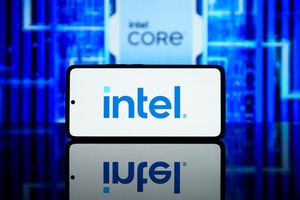
Apple Inc. (NASDAQ: AAPL) is currently experiencing a robust bullish trend, signaling a resurgence in investor and analyst confidence. After navigating a period of scrutiny regarding its artificial intelligence strategy and some market skepticism in early 2025, the tech giant has demonstrated remarkable resilience, underpinned by strong financial performance, accelerating services revenue, and a strategic recalibration of its AI initiatives. This sustained positive momentum is now reflected in key technical indicators and a wave of optimistic analyst upgrades, pointing towards a potentially significant upside for the stock.
The current bullish sentiment suggests that despite a maturing smartphone market and intense competition, Apple's fundamental strengths – its expansive ecosystem, loyal customer base, and diversified revenue streams – continue to be powerful drivers. Investors are closely watching how the company leverages its strong position to capitalize on future growth avenues, particularly in the evolving landscape of artificial intelligence and advanced computing.
Apple's Resilient Surge: A Deep Dive into Technicals and Analyst Sentiment
Apple's journey through late 2024 and 2025 has been a testament to its market resilience, culminating in its current bullish trajectory. A convergence of positive technical signals and a renewed wave of analyst confidence has propelled the stock forward. Several key technical indicators illustrate this strengthening position: as of April 2025, a "golden cross" emerged, with the 50-day moving average surpassing the 200-day moving average, a classic bullish signal. Observations in July 2025 noted tightening Bollinger Bands, often a precursor to a significant price movement, with an upside breakout favored in this context. The Moving Average Convergence Divergence (MACD) indicator showed a bullish crossover in July 2025, further confirmed by a rising MACD histogram in August, signifying increasing buying pressure. While the Relative Strength Index (RSI) touched overbought levels at various points, it has generally remained in neutral-to-bullish territory, avoiding consistent bearish signals.
This technical strength is mirrored by an increasingly positive outlook from financial analysts. The consensus price target for Apple currently ranges between approximately $240.33 and $247.45, with some firms like Tigress Financial setting an ambitious high of $305.00 on September 17, 2025. This optimism is not without recent impetus; on September 16, 2025, Mark Newman from Bernstein Société Générale Group initiated coverage with an "Outperform" (Buy) rating and a $290 price target, significantly bolstering market sentiment. However, the path was not entirely smooth, as September 11, 2025, saw some cautious downgrades from firms like DA Davidson and Phillip Securities, highlighting the dynamic nature of market perceptions.
The underlying reasons for this renewed confidence are multifaceted. Apple's robust financial performance has been a cornerstone, with the company reporting strong earnings per share (EPS) of $1.57 for the quarter ended June 28, 2025, comfortably surpassing analyst expectations. Revenue for the latest quarter hit approximately $94 billion, marking a significant 9.6% year-over-year increase. The services division continues to be a powerhouse, achieving an all-time high of $27.4 billion in Q3 FY25, showcasing a staggering 108% growth over five years. With over 1.1 billion paid subscriptions across its ecosystem, analysts anticipate double-digit growth for services revenue in FY25.
Critically, Apple's strategic pivot and enhanced focus on Artificial Intelligence (AI) have been instrumental. Initially criticized for a perceived slow entry into the AI race, particularly with its "Apple Intelligence" rollout in June 2024, the company has since clarified its unique, privacy-centric, on-device AI approach. CEO Tim Cook has emphasized AI as a "major turning point" for the company. Apple's partnerships with AI model providers like OpenAI and Anthropic, alongside internal development of an "answer engine," underscore its commitment. The introduction of the iPhone 16 series with Apple Intelligence in September 2024, new iPad Pro models with the M4 chip in May 2024, and subsequent updates to its ecosystem further solidify its market position, creating powerful customer lock-in that drives recurring, high-margin revenue. These developments, coupled with expectations of interest rate cuts by the Federal Reserve, paint a compelling picture for Apple's continued growth.
The timeline leading to this bullish phase includes the launch of the iPhone 15 series in September 2023, followed by new Macs in October 2023 and the M4-powered iPad Pro in May 2024. Apple's official "Apple Intelligence" reveal at WWDC in June 2024 set the stage, although a subsequent delay in a "more personalized Siri" in March 2025 led to a temporary stock dip. However, strong Q3 FY25 earnings in July 2025 and the recent bullish analyst initiations in September have swiftly turned the tide, reaffirming Apple's commanding presence in the technology landscape. Key players driving this narrative include CEO Tim Cook, leading the strategic vision, alongside figures like Craig Federighi in software engineering and analysts such as Mark Newman and Ivan Feinseth from Tigress Financial, who have been vocal proponents of Apple's stock.
Market reactions have been dynamic; while the initial "Apple Intelligence" announcements created buzz, the March 2025 Siri delay caused a significant over 20% stock drop in early 2025, with some investors like Warren Buffett's Berkshire Hathaway reducing their stake. However, the strong Q3 FY25 earnings in July and the subsequent wave of bullish analyst upgrades, notably Newman's "Outperform" rating on September 16, 2025, quickly shifted sentiment. The stock's positive performance following these upgrades indicates a renewed market recognition of Apple's strategic trajectory and confidence in its future earnings potential.
Apple's Ascension: A Shifting Landscape of Winners and Losers
Apple's (NASDAQ: AAPL) sustained bullish trajectory sends significant ripples across the global technology ecosystem, creating a clear delineation between those poised to benefit and those facing intensified competitive pressures. Unsurprisingly, Apple itself and its shareholders are the primary beneficiaries, basking in record revenues and robust growth driven by its iconic iPhone, expanding Mac lineup, and surging Services division. This financial strength empowers further innovation and strategic investments, reinforcing investor confidence.
The most immediate winners are found within Apple's vast supply chain. Component manufacturers providing semiconductors, displays, and camera modules, such as Analog Devices (NASDAQ: ADI), Qualcomm (NASDAQ: QCOM), and Murata Manufacturing (TYO: 6981), see heightened demand for their sophisticated products. Firms involved in the assembly and packaging of integrated circuits, like Amkor Technology (NASDAQ: AMKR), also directly benefit. Furthermore, Apple's strategic diversification of its manufacturing base to regions like the U.S., India, and Vietnam is a boon for local suppliers and manufacturers in these areas, with companies like Taiwan Semiconductor Manufacturing Company (NYSE: TSM) ramping up production for Apple's cutting-edge chips in Arizona.
Beyond hardware, the vibrant App Store ecosystem continues to mint successes for app developers. With cumulative earnings exceeding $320 billion since its inception, the platform remains a lucrative marketplace. The integration of "Apple Intelligence" and new AI tools is anticipated to spur the creation of more sophisticated and personalized applications, further cementing the App Store's value. Similarly, accessory makers, from those producing iPhone cases to Apple Watch bands, thrive on the massive installed base of Apple devices, enjoying substantial profit margins. Even Apple's own accessory lines, including AirPods and AirTags, contribute over $10 billion in quarterly revenue, highlighting the profitability of this segment. Indirectly, major cloud providers like Amazon Web Services (NASDAQ: AMZN), Google Cloud (NASDAQ: GOOGL), and Microsoft Azure (NASDAQ: MSFT) benefit from Apple's success, as Apple reportedly spends over $1 billion annually on AWS alone to power iCloud and other online services.
Conversely, Apple's relentless ascent intensifies pressure on its competitors. Smartphone manufacturers, particularly those in the Android ecosystem such as Samsung (KRX: 005930), Xiaomi (HKG: 1810), Oppo, and Vivo, face an uphill battle, especially in the premium segment where Apple dominates. While Android maintains a larger global market share, Apple consistently leads in developed markets like the U.S. Google's (NASDAQ: GOOGL) Pixel series, despite its AI prowess, struggles against Apple's integrated ecosystem and its privacy-focused, on-device AI approach. In the crowded streaming market, Apple TV+ poses a growing threat to established players like Netflix (NASDAQ: NFLX), Amazon Prime Video (NASDAQ: AMZN), Disney+ (NYSE: DIS), and Max (NASDAQ: WBD), forcing them to innovate content and pricing strategies to retain subscribers.
The tech giant's rumored "Project ACDC" – an internal initiative to launch its own cloud computing service leveraging M-series chips – presents a potential long-term threat to hyperscalers like Amazon Web Services, Microsoft Azure, and Google Cloud, aiming for more cost-effective and efficient solutions. Other tech giants also feel the competitive pinch; Google's advertising revenue could be affected by Apple Intelligence's privacy implications, while Microsoft faces intensified pressure in personal computing and AI. Intel (NASDAQ: INTC) has already seen a significant negative impact from Apple's successful transition to proprietary M-series chips for its Mac lineup, drastically reducing its reliance on Intel processors. Even Qualcomm, while a supplier, will need to vigorously pursue its "AI PC" and "AI Phone" initiatives to compete in the broader market against Apple's vertically integrated silicon strategy.
Industry-Wide Impact and Broader Implications of Apple's Ascent
Apple's (NASDAQ: AAPL) sustained bullish trend is not merely a corporate success story; it's a significant force reshaping the broader technology landscape. This momentum is intricately woven into major industry trends, from the paradigm shift in AI integration to the burgeoning services economy and crucial supply chain reconfigurations.
The most profound impact stems from Apple Intelligence and its privacy-focused approach to Artificial Intelligence. By emphasizing on-device processing and Private Cloud Compute (PCC), which allows for verifiable, transparent data handling, Apple is setting a new industry benchmark for AI privacy. This approach allows users to harness powerful AI without compromising personal data, leveraging advanced Neural Engines in newer devices. This strategy not only builds greater user trust and control but also positions Apple ahead of increasingly stringent global privacy regulations, potentially influencing future policy frameworks. For the enterprise sector, Apple Intelligence promises productivity gains, although it may necessitate upgrades to newer, AI-equipped devices. However, the demand for powerful hardware to support on-device AI could lead to higher consumer costs while simultaneously boosting sales of newer Apple devices.
Apple's burgeoning services economy continues to be a crucial driver of its growth and a blueprint for the industry. Services, encompassing the App Store, Apple Music, iCloud, and Apple Pay, offer stable, high-margin revenue streams (around 70% gross margin compared to hardware's 30%) that diversify the company's income and hedge against hardware market fluctuations. This seamless integration of services with Apple hardware creates a powerful "network effect," fostering customer loyalty and raising switching costs for users. Apple's "less is more" strategy in streaming, prioritizing quality over quantity, is also influencing competitors like Netflix (NASDAQ: NFLX) and Disney (NYSE: DIS) to re-evaluate their content strategies. However, the App Store's business model, particularly its commission fees and restrictions on alternative payment systems, remains a hotbed for regulatory scrutiny and antitrust challenges in various regions, notably under the European Union's Digital Markets Act (DMA).
Furthermore, Apple is actively recalibrating its global manufacturing operations, shifting production of U.S.-bound products, especially iPhones, from China to countries like India and Vietnam. This strategic move is a direct response to geopolitical risks, tariffs, and a broader industry imperative for enhanced supply chain resilience. Apple's "China Plus One" strategy lends significant momentum to other multinationals like Samsung (KRX: 005930), Google (NASDAQ: GOOGL), and Dell (NYSE: DELL) in diversifying their production bases. This shift brings increased investment and job creation to host countries while simultaneously posing long-term challenges in replicating China's dense supplier ecosystem and infrastructure. Companies deeply integrated into Apple's supply chain, such as Corning (NYSE: GLW), Taiwan Semiconductor Manufacturing Company (NYSE: TSM), and Texas Instruments (NASDAQ: TXN), stand to benefit from these investments in new manufacturing regions.
The ripple effects of Apple's dominance extend to intense competition in the AI race, forcing rivals to innovate not only in AI capabilities but also in their data privacy practices. The strength of Apple's "walled garden" ecosystem reinforces customer loyalty, making it challenging for competitors to attract and retain users, while also prompting regulatory concerns about fostering a competitive market. Historically, Apple's current trajectory echoes periods of dominance seen with companies like IBM (NYSE: IBM) and Microsoft (NASDAQ: MSFT) in the late 20th century, where they set industry standards and faced similar questions about market power and innovation. Apple itself has a history of innovation-driven comebacks, from the original Mac to the iPod and iPhone, proving its capacity to reshape industries. Its current AI push aims to be another such transformative moment, solidifying its position as one of the "Magnificent Seven" tech giants whose collective growth continues to fuel debates about market concentration and the need for regulation.
What Comes Next: Navigating Apple's Future Trajectory
Apple's (NASDAQ: AAPL) bullish momentum sets the stage for a dynamic period, characterized by an aggressive product roadmap, strategic pivots, and adaptations to a rapidly evolving technological and regulatory landscape. Both short-term developments and long-term ambitions underscore the company's commitment to sustained growth and innovation.
In the short term, late 2025 and early 2026 will see a flurry of anticipated product launches designed to solidify Apple's market leadership and expand its ecosystem. This includes the expected M5 iPad Pro, an updated Vision Pro headset, the AirTag 2 with enhanced precision finding, and faster Apple TV and HomePod mini 2 devices, all poised to integrate with the new Siri powered by Apple Intelligence. Early 2026 will also bring M5 MacBook Pro and Air models, along with the iPhone 17e, targeting the mid-range segment. Earnings calls will continue to be closely watched, with analysts maintaining a generally optimistic outlook, forecasting double-digit growth for services revenue and a 4% year-over-year increase in overall revenue for FY25. However, concerns about Apple's comparative pace in advanced AI integration could lead to continued investor scrutiny. Competition from tech giants like Samsung (KRX: 005930), Google (NASDAQ: GOOGL), Microsoft (NASDAQ: MSFT), and Amazon (NASDAQ: AMZN) will remain fierce, necessitating Apple's strategic expansion into mid-range smartphones and smart home products to broaden its addressable market. Furthermore, ongoing supply chain diversification efforts, particularly shifting iPhone production to India and Vietnam, will continue, although replicating China's scale and efficiency remains a formidable short-term challenge. Regulatory scrutiny, especially from the EU's Digital Markets Act (DMA), will persist, potentially impacting the App Store's revenue model and Apple's "walled garden" approach.
Looking further ahead, Apple's long-term strategy involves a significant pivot towards prioritizing its services business and integrating AI as the backbone of its entire ecosystem. This commitment extends to developing proprietary operating systems and software technologies to maintain a competitive edge. Significant market opportunities lie in refining AI integration, with an AI-driven Siri ("World Knowledge Answers") anticipated for release in spring 2026 with iOS 26.4, which could potentially disrupt its search agreement with Google. Apple's AI strategy emphasizes practical utility and privacy, aiming to revolutionize user workflows. The company is also making a bold move into the smart home sector with a planned dedicated smart home hub and updated HomePods by spring 2026, intensifying competition with Amazon Alexa and Google Home. Spatial computing, spearheaded by the Vision Pro, represents another long-term commitment to foundational technology. Perhaps the most ambitious long-term project is "Project Titan," the Apple Car, now slated for release no earlier than 2028. While scaled back from a fully autonomous vision to a Level 2+ system for highway driving, it aims to integrate Apple's software expertise and create a seamless ecosystem among home, car, and work, potentially disrupting the automotive industry.
Despite these opportunities, long-term challenges loom. Intensified competition in AI from rivals like Nvidia (NASDAQ: NVDA) and Microsoft (NASDAQ: MSFT) could challenge Apple's premium valuation if its pace of innovation is perceived as slower. Persistent global regulatory scrutiny and potential antitrust fines, such as the €13 billion tax bill from the EU finalized in early 2025, could impact profitability and business models. Building a resilient supply chain outside China presents significant costs and complexities, including infrastructure gaps and workforce training challenges. Some analysts also suggest Apple needs to reignite truly revolutionary innovation rather than primarily iterating on existing concepts to maintain brand loyalty and market share. However, if Apple successfully leverages its product pipeline, integrates its privacy-centric AI, and expands into new categories like smart homes and automotive, it could further entrench its ecosystem, attract new users, and redefine industry benchmarks.
Conclusion: Apple's Enduring Strength Amidst Evolving Challenges
Apple's (NASDAQ: AAPL) current bullish trend is a testament to its enduring resilience, strategic adaptability, and the fundamental strength of its meticulously crafted ecosystem. The company has skillfully navigated periods of skepticism, emerging with renewed analyst confidence and robust financial indicators. Key takeaways from this positive momentum include the pivotal shift towards a services-driven growth model, which now contributes significantly to Apple's valuation and boasts impressive gross margins of around 76%. This, coupled with an ever-expanding global user base and the anticipated impact of Apple Intelligence across its operating systems, forms a formidable foundation for continued growth. Apple's aggressive product pipeline, featuring the iPhone 17 series, updated Vision Pro headsets, and M5-powered devices, along with an optimistic outlook for increasing average selling prices (ASPs), further reinforces its market position. The company's exceptional brand loyalty and strong financial health continue to enable strategic capital allocation through share buybacks and dividends, bolstering earnings per share.
Moving forward, the market presents both significant opportunities and notable challenges for Apple. Sustained services momentum and the expected surge in iPhone sales driven by the iPhone 17 and integrated AI features are clear growth catalysts. New market expansions, particularly in augmented reality with Vision Pro updates and potential foldable devices, could unlock entirely new revenue streams, while strategic focus on emerging markets like India and Southeast Asia offers substantial growth potential. However, Apple faces headwinds from intensified competition, particularly in the hardware segment where iPhone sales have shown signs of stagnation in saturated markets. Regulatory scrutiny, especially from the U.S. Department of Justice (DOJ) and the EU's Digital Markets Act (DMA), continues to threaten Apple's long-standing business practices and ecosystem control. While Apple Intelligence is a significant step, the company must effectively differentiate its privacy-focused AI solutions amidst fierce competition from established AI leaders like Google (NASDAQ: GOOGL), Microsoft (NASDAQ: MSFT), and OpenAI. Geopolitical tensions and the complexities of diversifying its supply chain away from China also pose ongoing logistical and financial risks. Furthermore, Apple's premium valuation, despite projecting slower revenue growth compared to some tech peers, demands consistent innovation and execution to justify investor confidence.
Apple's enduring significance lies in its unparalleled ability to remain a dominant force in the technology sector through continuous innovation, strategic user base expansion, and adept management of external pressures. Its integrated hardware, software, and services ecosystem creates formidable switching costs, fostering unparalleled customer loyalty. Historically, Apple has consistently been a trendsetter, revolutionizing industries with products like the iPhone and iPad. Future launches, especially in spatial computing with the Vision Pro, are expected to continue setting industry standards for user experience, privacy, and integration. The strategic pivot towards high-margin, recurring services revenue provides a robust and resilient business model, capable of sustaining earnings growth even amidst the maturation of its core hardware segments.
For investors in the coming months (Q4 2025 - Q1 2026), several key indicators warrant close attention. Monitor early sales figures and market reception for the iPhone 17 series, particularly how its new AI capabilities resonate with consumers and impact upgrade cycles. Continuously track the growth rate and profitability of Apple's services segment, as this remains a critical driver of overall earnings and valuation. Assess the adoption and market expansion of newer product categories, especially updates to the Vision Pro and any potential announcements regarding foldable devices. Key insights will also come from the performance and market acceptance of the new M5 chip across the iPad Pro and Mac lineups. Investors should stay informed about developments in antitrust lawsuits and regulatory compliance efforts, especially in the European Union, as these could impact Apple's business model and financial structure. Finally, closely watch Apple's sales and market share performance in China, given the intensifying local competition, and evaluate how tariff-related costs continue to affect its gross margins. Upcoming earnings reports, particularly the Q4 2025 report (estimated around October 30, 2025) and subsequent Q1 2026 guidance will provide crucial insights into the company's financial health, revenue projections, and outlook for the coming year. While Apple navigates a complex landscape of competition and regulatory pressures, its entrenched ecosystem, robust services business, and innovative product pipeline, particularly with the integration of AI and new form factors, provide a strong foundation for continued bullish sentiment and long-term growth.





